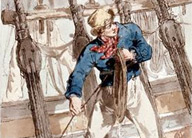Have you ever seen a nautical movie and dreamed of living a sailor’s life? We dream that silly dream because we don’t really understand how hard their job really was.
No matter how cold and wet you were (very and always), you still had to do the back-breaking work – and on a terrible diet, too!
Imagine working 100 feet up a telephone pole during a hurricane, except the pole is attached to a skateboard and your job is to tie ropes together. No gloves, no shoes, and a wet, cold rope. And all you had to eat that day was bread that required soaking in water just to make it digestible.
You did this every day for two years. Your home when you weren’t working (a mere eight hours per day) was a dark, moldy corner at the bottom of the ship. Oh, and when you wore through your clothes? You made your new ones from ruined sails, or a roll of fabric you brought on board when you left Boston the year before.
Unsurprisingly, the whip didn’t motivate
Surprisingly, sailors usually went about their work with pep in their step.
If it was possible to get a crew to want to work under these conditions, how hard can it be to get Cindy from accounting to stop annoying everyone and just do her job?
Of course they used the stick a lot back then – a whip in fact. And it was perfectly legal. The ship’s captain had authority like no other boss, but surprisingly, the stick was an ineffective motivator.
A crew that felt harm done could retaliate by working at a ‘normal’ speed. (they were just as petty in the 18th century as we are today, after all). If you’ve ever “showed them” by doing an absurdly thorough job to make a 10 minute task take three hours, you know what I’m talking about.
Or, the crew could also really embarrass their captain by being methodical when docking (a job that requires split-second timing) and cause the ship to smack into the dock or another boat. And the captain couldn’t punish someone for doing his job thoroughly, now could he?
Sailors found singing builds camaraderie
All this in mind, the first officer (who was really the chief motivation officer) needed to find better ways to pep up his crew. One way was singing.
Recent studies have shown that singing works — Marching To The Beat Of The Same Drummer Improves Teamwork, (Association for Psychological Science, Jan. 28, 2009) and Is There a Dark Side to Moving in Sync? (Science Daily, USC Marshall School of Business, Jan. 11, 2012) — and so does marching and chanting.
 While hauling up an anchor chain, for instance, a song was worth two men. The rhythm of the tune and camaraderie it encouraged got everyone to work in unison – and nothing lightens a load like cooperation, something no whip can force.
While hauling up an anchor chain, for instance, a song was worth two men. The rhythm of the tune and camaraderie it encouraged got everyone to work in unison – and nothing lightens a load like cooperation, something no whip can force.
To apply this principle today, your office doesn’t have to sound like a pirate bar on a Friday night. Any type of cooperative task works, even if it’s taking a walk or doing a community crossword puzzle. According to studies, the team bond forged during these tasks remains when the employees go back to their desks.
Getting your crew to at “with a will”
Sailors have an expression: when they wanted to do something quickly, they did it “with a will.”
The role of a leader is to get his crew to act “with a will,” and if it takes a song, sing. Eat together, or sit around and just talk – almost anything works as long as it’s fun and requires participation.
As the leader of a team, it’s up to you to get that team working in unison, and you can use proven psychology to your advantage. If you aren’t in charge yet, use this technique to become the de facto team leader and soon the title will follow.
Unfortunately, you can’t beat your employees anymore, so you need to get them to sing instead and they will want to pull “with a will.”
